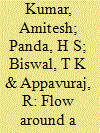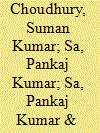| Srl | Item |
| 1 |
ID:
136039


|
|
|
|
|
| Summary/Abstract |
Flow around a conical nose with rounded tail projectile has been studied numerically for subsonic, transonic and supersonic flow regimes. The conic angle of the projectile is 10°. The inflow Mach numbers are 0.5, 0.9, and 1.5. Axisymmetric Euler’s equations are solved for predicting the drag coefficient. It has been observed that even for a subsonic flow regime, the Mach number distribution is not uniform owing to the non-symmetric shape of the projectile. The predicted drag coefficients for subsonic, transonic, and supersonic cases are 0.018, 0.089, and 0.395, respectively. It was observed that rounded tail is a better option than boat tail so far drag force is concerned.
|
|
|
|
|
|
|
|
|
|
|
|
|
|
|
|
| 2 |
ID:
136042


|
|
|
|
|
| Summary/Abstract |
Deformation study of projectile immediately after firing is essential for its successful impact. A projectile that undergoes more than the tolerated amount of deformation in the barrel may not produce the requisite results. The study of projectile deformation before its impact requires it to be imaged in flight and perform some computation on the acquired image. Often the deformation tolerance is of the order of tens of micrometer and the acquired image cannot produce image with such accuracy because of photographic limitations. Therefore, it demands sub-pixel manipulation of the captured projectile image. In this work the diameter of a projectile is estimated from its image which became blur because of slow shutter speed. First the blurred image is restored and then various interpolation methods are used for sub-pixel measurement. Two adaptive geometrical texture based interpolation schemes are also proposed in this research. The proposed methods produce very good results as compared to the existing methods.
|
|
|
|
|
|
|
|
|
|
|
|
|
|
|
|